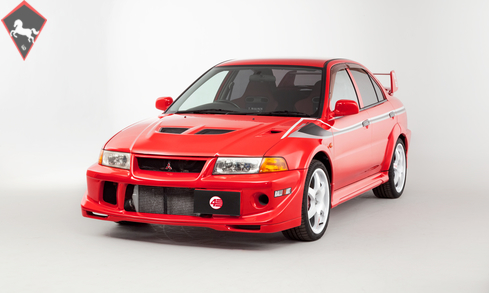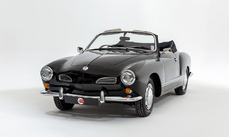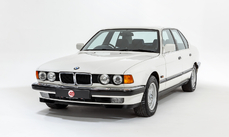Mitsubishi Lancer VI Tommi Makinen 2000
Allmän beskrivning :
Model History
The Lancer Evolution was a high-performance sports car based on the standard Mitsubishi Lancer. There have been ten official versions to date, and the designation of each model is most commonly a Roman numeral. All use two-litre, turbocharged engines and all-wheel drive systems.
The Evolution was originally intended only for Japanese markets, but demand on the "grey import" market led the Evolution series to be offered through Ralliart dealer networks in the United Kingdom and in various European markets from around 1998. Japanese-spec cars were limited by a gentlemen's agreement to advertise no more than 276hp, a mark already reached by Evolution IV. Therefore, each subsequent version has unofficially evolved above the advertised power figures, with the Japanese-spec Evolution IX reaching an alleged output of around 317hp.
The Evo VI was produced from January 1999 until March 2001. The improvements over its predecessor mainly focused on cooling and engine durability. It received a larger intercooler, larger oil cooler, and new pistons. The Evolution VI received new bodywork yet again, with the most easily noticeable change being within the front bumper where the huge fog lights were reduced in size and moved to the corners for better airflow.
Great rally success was achieved in the WRC Rallies from 1996-1999 thanks to the legendry Finn Tommi Makinen for clinching the drivers titles in this period and help from team mate Richard Burns for clinching the constructors championship for the first, and thus far only time in 1998.
In 1999 the Tommi Makinen Edition was released. It featured a different front bumper, red and black Recaro seats embossed with the Tommi Makinen logo, 17-inch white Enkei wheels, a red-stitched leather Momo steering wheel and shift knob, a titanium turbine that spooled up more quickly, front upper strut brace, lowered ride height (with tarmac stages in mind), and a quicker steering ratio, among other things. The car is sometimes referred to as an Evolution 6.5, or TME for short.
The Tommi Makinen Edition was only available in Scotia White, Satellite Silver, Pyrenees Black, Canal Blue, and Passion Red (the only colour scheme available with the Works stripes and decals kit). Out of all the colours, the red is considered to be most collectable; certainly the used car market favours it as values are seen to be increasing year on year. In total there were 2,021 GSR and just 678 RS lightweight variants. It is believed that only 212 cars were produced in red with the Special Colour Pack.
Equipment
Special Colour Pack, TME embroidered Recaro front seats, 18-inch Compomotive MO1882 alloy wheels, Front and side airdams, Twin-wing rear spoiler with high-mount stop lamp, Specially tuned suspension, Brembo brakes, Electric-folding door mirrors, Digital climate control AC, Electric windows, Power steering, Momo leather steering wheel with red stitching, Leather gear knob and gaiter with red stitching, Front airbags, Remote central locking, Radio delete, Kakimoto Racing stainless exhaust, Mitsubishi wind deflectors, Privacy glass, Spare wheel.
Exterior
The gleaming Passion Red paintwork looks superb alongside the Works stripes and decals. Visually similar to the Championship winning cars made famous by rally legend Tommi Makinen, it comes as no surprise that Special Colour Pack TMEs like this one have fast become the most sought after of all. Amazingly there is no fading or damage to the bodywork and almost no stone chips to the front end. None of the trims or rubbers have ever been sun-damaged and the decals present extremely well all round.
Interior
The specially-embroidered TME Recaro seats present really well and show few signs of use; the velour bolsters are usually the first areas to wear but these remain in excellent order with no rips or bobbling to report. The dash and centre console are also free from any significant marks and pleasingly there are no aftermarket gauges or controllers fitted. Commonly worn items such as the steering wheel and gear knob are in good original condition, not entirely unworn but perfectly in line with the mileage.
ENGINE & TRANSMISSION
The turbocharged 2-litre rockets the Evo from 0-60 mph in little over 4 seconds. The five-speed manual gearbox still feels tight, and the all-wheel-drive system provides enough confidence to power though corners at speed. Despite its high-performance credentials, the Evo VI still drives with typical Japanese-car ease; operating smoothly at low speeds before launching into ferocious acceleration at anything above 4000 rpm.
The engine bay of this example is remarkably original with absolutely no modifications or aftermarket components fitted; even the factory blow-off valve is still in place. The car presents in excellent mechanical fettle having received a full service, cambelt change, and new clutch at Mitsubishi around 200 miles ago. Sold with a fresh 12 month MOT.
WHEELS, TYRES & BRAKES
The Evo sits on stunning six-spoke Compomotive alloys, all in perfect unmarked condition having seen little use since fitting. They are shod in matching Goodyear rubber with at least 6mm of tread remaining at each corner. Out on the road the Brembo brakes perform effortlessly, stopping the car quickly and in a straight line.
History File
This rare Special Colour Pack Tommi Makinen was first registered in February 2000. It was supplied new in Japan, remaining there until late 2016 when it was imported by 4 Star. It has been carefully stored with us ever since and is now offered for sale for the first time in the UK, fully registered and with 12 months MOT upon sale.
The paperwork is complete with Japanese service history, original owner’s manuals, UK registration documents, and Mitsubishi invoices for the recent cambelt service and clutch replacement; the work was carried out by Farnham Mitsubishi little over 200 miles ago at a cost of over £2,800.
http://www.4starclassics.com/for-sale/mitsubishi-evo-vi-tommi-makinen-for-sale/
2000 Mitsubishi Lancer VI Tommi Makinen is listed såld on ClassicDigest in Kingsley by 4 Star Classics for £39995.
Fakta i bilen
Karosstyp : Personbil Märke : Mitsubishi Modell : Lancer Modellversion : VI Tommi Makinen Motorvolym : 2.0 Årsmodell : 2000 Karosstyp : Pick up Läge : Hampshire
Såld
Information om säljaren
Såld
People who viewed this Mitsubishi Lancer also viewed similar Mitsubishi listed at ClassicDigest
Other cars listed for sale by this dealer
om Mitsubishi
Mitsubishi: En Resa Genom Historien (fram till 1980-talet)1. Tidiga Ursprung:
Grundande: Mitsubishis rötter sträcker sig till grundandet av ett rederi av Yataro Iwasaki år 1870.
Diversifiering: Företaget utvidgade till kolgruvdrift, skeppsbyggnad och andra branscher, vilket lade grunden för Mitsubishi Group.
2. De Första Fordonsförsöken:
Inledande Biltillverkning: Mitsubishi vågade sig in i biltillverkning i början av 1900-talet.
Modell-A: År 1917 introducerade Mitsubishi sin första serieproducerade bil, Modell-A, Japans första serieproducerade bil.
3. Efterkrigstiden:
Omstrukturering: Efter andra världskriget mötte Mitsubishi utmaningar men genomgick omstrukturering och återupptog bilproduktionen.
Jeep-Produktion: Fokuserade initialt på att producera jeepar och bidrog betydande till Japans bilindustris återhämtning.
4. Milstolpsmodeller:
Mitsubishi 500: Introducerades 1960 och var en kompakt bil som spelade en roll för att popularisera mindre fordon i Japan.
Mitsubishi Colt 600: Släpptes 1962 och var en småbil som bidrog till Mitsubishis expansion på bilmarknaden.
5. Global Expansion och 1970-talet:
Partnerskap: Mitsubishi skapade partnerskap med internationella biltillverkare och expanderade därmed utanför Japan.
Galant och Lancer: Modeller som Galant och Lancer blev populära under 1970-talet och visade Mitsubishis engagemang för innovation och prestanda.
6. Teknologiska Framsteg:
Mitsubishi Astron-motor: Introducerades på 1970-talet och blev en standard i Mitsubishis fordon, känd för sin hållbarhet och effektivitet.
7. 1980-talets Höjdpunkt:
Mitsubishi Pajero: Lanserades i början av 1980-talet och markerade Mitsubishis inträde på SUV-marknaden, blev en global framgång.
Starion: Starion, introducerad mitten av 1980-talet, var en sportbil som visade Mitsubishis prestandakapacitet.
8. Klassiska Modeller från 1980-talet:
Mitsubishi Delica: Delica, först introducerad på 1960-talet men populär på 1980-talet, var en mångsidig van med olika konfigurationer.
Mitsubishi Mighty Max: Denna kompakta pickup var känd för sin hållbarhet och praktikalitet.
Mitsubishi Mirage: Mirage, tillgänglig som hatchback och sedan, blev populär för bränsleeffektivitet och pålitlighet.
Mitsubishis resa genom 1980-talet speglar dess utveckling från en mångfaldig koncern till en framstående aktör i den globala bilindustrin. Det var ett årtionde som introducerade ikoniska modeller och stärkte Mitsubishis rykte för innovation och prestanda.







